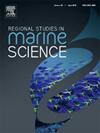Elevated concentration of selected heavy metals in Gadani shipbreaking area, Pakistan
IF 2.4
4区 环境科学与生态学
Q3 ECOLOGY
引用次数: 0
Abstract
The world's busiest ship-recycling hub, Gadani Beach in Baluchistan, Pakistan, may pollute the environment. This work provides the first complete and geographically resolved assessment of heavy metal pollution in Gadani shipbreaking region coastal sediments. Nine heavy metals were evaluated in 69 sediment samples from the shipbreaking site and a neighboring reference zone. Top 7 cm beach sand and sediments were collected from the yard zone and deconstruction zone at intertidal (0.3 m) and subtidal (2.4 m) depths. Additional sediment samples were taken from reference sites at 1.4–3 m depth. Two yard and dismantling zone replicates, and one reference site replicate were taken at each station. ICP-MS analyzed metals. Geoaccumulation Index and potential ecological risk index (PERI) were used to assess sediment contamination. Geoaccumulation Index and potential ecological risk index (PERI) were used to assess sediment contamination. Metal concentrations were 3–53 times greater in the shipbreaking area than at the reference location. The concentration hierarchy was Fe > Mn > Zn > Pb > Cr > Ni > As > Co > Cd, with Pb, Zn, and Ni above Effect Range Medium (ERM) criteria, implying ecological harm. Spearman correlation and cluster analysis showed substantial inter-metal correlations, indicating shared sources—primarily shipbreaking materials like paints, batteries, anodes, and lubricants. The yard zone was most polluted, followed by the seaward disassembly zone. Sediment Quality Guidelines (SQGs), Contamination Factor (Cf), Geoaccumulation Index (Igeo), and δ¹ ³C isotopic fingerprints identified anthropogenic oil inputs and environmental hazards. This study provides essential baseline data for regional ship recycling regulatory frameworks and environmental management.
巴基斯坦加达尼拆船区某些重金属浓度升高
世界上最繁忙的船舶回收中心,巴基斯坦俾路支省的加达尼海滩,可能会污染环境。这项工作提供了Gadani拆船区沿海沉积物中重金属污染的第一个完整的和地理上解决的评估。对拆船现场及邻近参考区69份沉积物样本中的9种重金属进行了评估。在潮间带(0.3 m)和潮下带(2.4 m)处收集了Top 7 cm的海滩沙和沉积物。在1.4-3 m深度的参考地点采集了额外的沉积物样本。在每个站点进行了两次场地和拆除区复制,并进行了一次参考站点复制。ICP-MS分析金属。利用地质累积指数和潜在生态风险指数(PERI)对沉积物污染进行评价。利用地质累积指数和潜在生态风险指数(PERI)对沉积物污染进行评价。拆船区的金属浓度是参考位置的3-53 倍。浓度等级为Fe >; Mn >; Zn >; Pb >; Cr >; Ni >; As >; Co >; Cd, Pb、Zn、Ni均高于效应范围中等(ERM)标准,具有生态危害。Spearman相关和聚类分析显示了大量的金属间相关性,表明了共同的来源——主要是拆船材料,如油漆、电池、阳极和润滑剂。堆场区污染最严重,其次是向海拆解区。沉积物质量准则(SQGs)、污染因子(Cf)、地质累积指数(Igeo)和δ¹ ³C同位素指纹图谱识别了人为石油输入和环境危害。本研究为区域船舶回收监管框架和环境管理提供了必要的基线数据。
本文章由计算机程序翻译,如有差异,请以英文原文为准。
求助全文
约1分钟内获得全文
求助全文
来源期刊

Regional Studies in Marine Science
Agricultural and Biological Sciences-Ecology, Evolution, Behavior and Systematics
CiteScore
3.90
自引率
4.80%
发文量
336
审稿时长
69 days
期刊介绍:
REGIONAL STUDIES IN MARINE SCIENCE will publish scientifically sound papers on regional aspects of maritime and marine resources in estuaries, coastal zones, continental shelf, the seas and oceans.
 求助内容:
求助内容: 应助结果提醒方式:
应助结果提醒方式:


